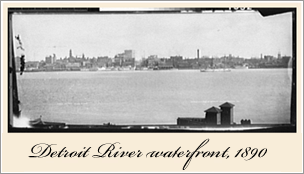

The first U.S. Land Office in Michigan was established in 1804 and during the 1830s, it became one of the busiest in the nation. A combination of cheap land and improved transportation, due to the opening of the Erie Canal, brought a flood of settlers to Michigan. Many passed through Detroit and during the land rush peak in 1836, boats carrying over 500 people were an almost daily occurrence in Detroit.
The growth that Detroit experienced after the Civil War had its beginnings in the 1840s and was tied to Michigan's natural resources, specifically copper, iron, and lumber. Shipments of these materials made their way to Detroit, and the face of the city changed to accommodate the resulting industries.
In the years after the Civil War, Detroit was transformed from a mercantile city to one of the nation's major industrial centers, and factories, warehouses and rail lines were built along the Detroit River. Thousands of workers produced a seemingly endless list of products: railroad cars, ships, stoves, cigars, shoes, seeds, pharmaceuticals, and paints and varnishes.
Previous Page | Next Page
